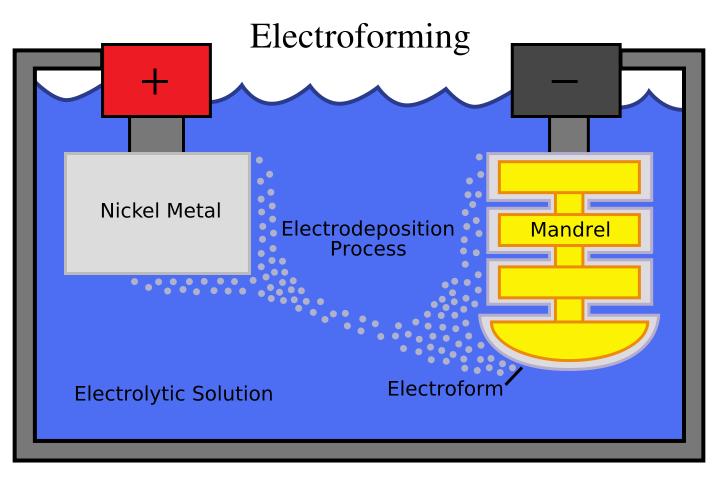
|
|
|
|
|
| |
What is electroforming? |
| |
|
|
Electroforming is a highly specialized process of metal part fabrication using electrodeposition in a plating bath over a base form or mandrel which is subsequently removed. Technically, it is a process of synthesizing a metal object by controlling the electrodeposition of metal passing through an electrolytic solution onto a metal or metallized form. More simply, a metal skin is built up on a metal surface, or any surface that has been rendered electroconductive through the application of a paint that contains metal particles. Essentially, a metal part is fabricated from the plating itself.
This differs from electroplating basically because the skin is much thicker and can exist as a self-supporting structure if the original matrix, or mandrel, is removed. The object being electroformed can be a permanent part of the end product or can be temporary (as in the case of wax), and removed later, leaving only the metal form, the “electroform”.
New technologies have made it possible for mandrels to be very complex. In order to facilitate the removal of the electroform from the mandrel, a mandrel is often made of aluminum. Because aluminum can easily be chemically dissolved, a complex electroform can be produced with near exactness.
The advantage of the electroforming process is that it reproduces the form or mandrel to within one micrometre without the shrinkage and distortion associated with other metal forming techniques such as casting, stamping or drawing. And, since the mandrel is machined as an outside surface, close dimensional tolerances and high surface finishes can be held and maintained on complex interior configurations.
In recent years, due to its ability to replicate a mandrel surface precisely atom-by-atom with practically no loss of fidelity, electroforming has taken on new importance in the fabrication of micro and nano scale metallic devices and in producing precision injection molds with micro and nano scale feature for production of nonmetalic micromolded objects. Electroforming tolerances of 1.5 to 3 nanometres have been reported by some precision fabricators.
In the basic electroforming process, an electrolytic bath is used to deposit nickel or other electroplatable metal onto a conductive patterned surface, such as glass or stainless steel. Once the plated material has been built up to the desired thickness, the electroformed part is stripped off the master substrate. This process allows high-quality duplication of the master and therefore permits quality production--at low unit costs with high repeatability and excellent process control.
Compared to other basic metal forming processes (casting, forging, stamping, deep drawing, machining and fabricating) electroforming is very effective when requirements call for extreme tolerances, complexity or light weight. The precision and resolution inherent in the photographically produced conductive patterned substrate, allows finer geometries to be produced to tighter tolerances while maintaining superior edge definition with a near optical finish. Electroformed metal is extremely pure, with superior properties over wrought metal due to its refined crystal structure. Multiple layers of electroformed metal can be molecularly bonded together, or to different substrate materials to produce complex structures with "grown-on" flanges and bosses.
A wide variety of shapes and sizes can be made by electroforming, the principal limitation being the need to strip the product from the mandrel. Since the fabrication of a product requires only a single pattern or mandrel, low production quantities can be made economically. |
| |
|
| |
 |
| |
|
| |
The differences between electroforming and photo-electroforming |
| |
|
| |
The electroforming process has been used in industry for many decades. This is an electrochemical process very similar in principle to electrolytic coating processes, but instead of a thin coating of a few microns, it is used for producing metal parts. The traditional electroforming process produces the form of the negative of the required product from any kind of metal, usually aluminum, and that is the mandrel. The mandrel is used as a cathode on which the nickel is built. At the end of the process the product is removed from the mandrel.
In contrast to the electroforming process, in the Photo-Electroforming process products are manufactured by a combination with a photolithographic process, which is similar in principle to the process used in photo-etching. This combination of the photolithographic and the electroforming processes allows for the manufacture of thin, flat metal parts, without creating internal stress and highly accurate. |
| |
|
|
|
|
|
|
|
 You are Here: Home > About electroforming
You are Here: Home > About electroforming
 Back
Back

 You are Here: Home > About electroforming
You are Here: Home > About electroforming
 Back
Back
